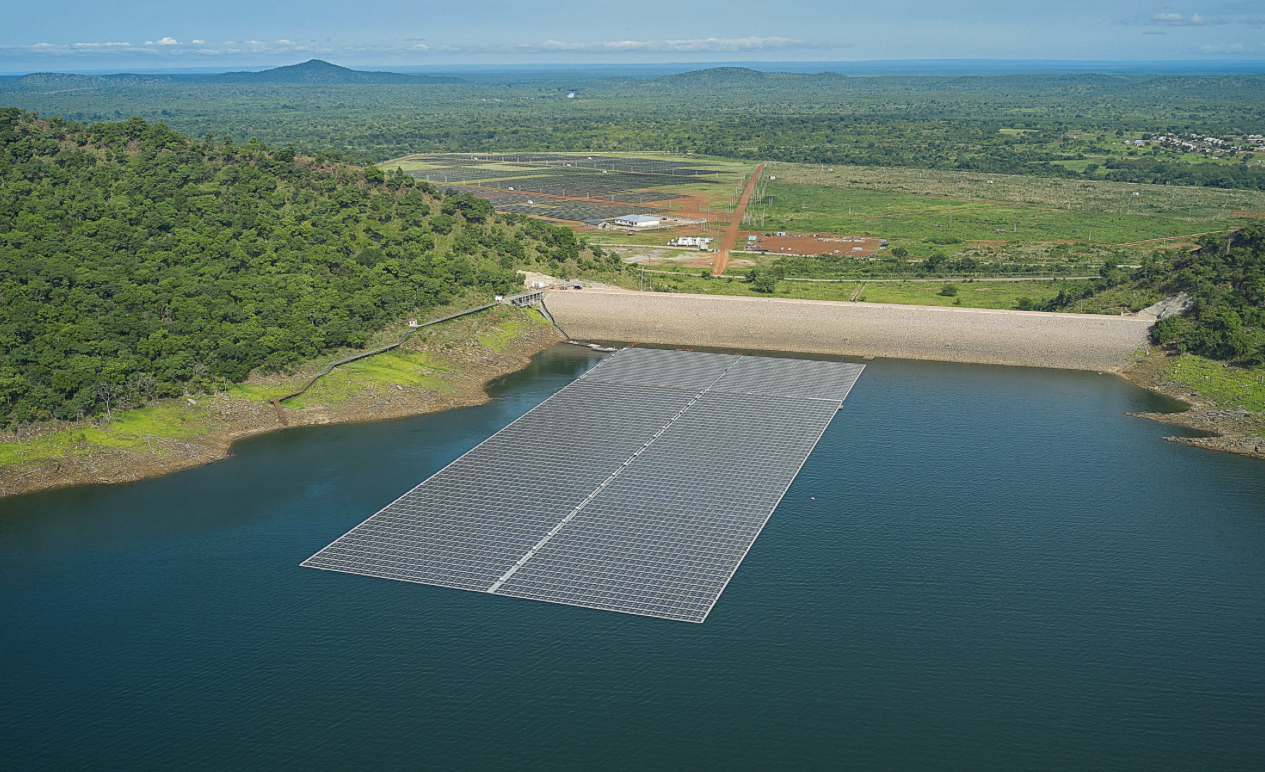
New promise for floating solar is just one of the innovations that crossed our desks this summer. (Image: Kalyakan/Adobe Stock)
Solar energy innovations are all over the news as scientists develop new ways to produce more power from the sun and the true potential of solar to reduce emissions becomes clear. Generating energy from solar and wind is now cheaper than oil and gas in most scenarios, and investment in renewables is set to double investment in fossil fuels this year.
That all adds up to more countries meeting more of their energy needs with renewable sources. The European Union met half its power needs with renewable energy from solar, wind and hydropower in the first half of 2024, and the bloc's use of solar power in particular increased by over 30 percent since 2020. With efficiency upgrades and game-changing design shifts on the horizon, the world's love affair with solar is just getting started. Read on for some of the hottest news that crossed our desks this summer.
Solar without the panels? Printable and paintable solar could soon be a reality
Scientists at Oxford University say they've developed an ultra-thin and flexible material that can be applied as a coating on objects like building walls, roofs, cars and cell phones to generate solar energy without the need for solar panels. “If more solar energy can be generated in this way, we can foresee less need in the longer term to use silicon panels or build more and more solar farms,” Junke Wang of Oxford’s physics department said in a statement released by the university last week.

The idea of generating solar from everyday objects is nothing new. Researchers from Singapore's Nanyang Technological University debuted a thin solar cell that doubled as a touchscreen a decade ago. Bringing it into the real world proved challenging, but new developments could change that.
The key to this ultra-thin solar material is a relatively inexpensive mineral called perovskite, composed of calcium and titanium, and Oxford's isn't the only research team experimenting with it. Researchers at the City University of Hong Kong also unveiled a perovskite solar material this month which they say is essentially printable for inexpensive production on a mass scale, just like "printing newspapers," said Alex Jen Kwanyue, chair of the university's materials science department.

Importantly, both teams are reaching new heights in power conversion efficiency. The City University of Hong Kong's material reached around 26 percent efficiency in lab testing, which means it converts 26 percent of the sunlight that hits it into energy. Oxford's surpassed 27 percent, nearing “the limits of what single-layer voltaics can achieve today," Shuaifeng Hu of the university's physics department said in a statement. "We believe that, over time, this approach could enable the photovoltaic devices to achieve far greater efficiencies, exceeding 45 percent," he said.
The research teams say innovations like these will continue to decrease the cost of solar, which is already 90 percent cheaper than it was in 2010, while opening new possibilities for solar development with less space.

Solar windows take a major step toward the mainstream
Even as researchers reach new breakthroughs in developing ultra-thin solar film, maintaining the transparency of this material so it can be used on building windows is another matter.
The California startup Next Energy Technologies is among those looking to commercialize solar windows, and it installed a demo window at the design and architecture firm Gensler's headquarters in Los Angeles earlier this summer. At only around 6.5 square feet, the test window is small, but it carries big implications for a technology more than two decades in the making.
Rather than the silicon used in standard solar panels or the perovskite used in films, Next Energy coats glass with organic materials to generate energy from the sun. The organic semiconductors it uses today were first discovered at the University of California Santa Barbara, where the company was formed, earning the research team a Nobel Prize for Chemistry back in 2000.
The company says the test brings it one step closer to bringing a full-size solar window to the market. “It’s rewarding to see our technology developed to the point where commercialization can be realized and demonstrated to architects, glass fabricators and framing system providers,” CEO Brenton Taylor said in a statement. Gensler co-chairman Andy Cohen called the company's technology "an innovation breakthrough for architects that will transform the game plan for sustainable buildings."
Two is better than one for solar thermal, with China's dual-tower plant boosting efficiency by 24 percent
Rather than flat panels that convert the sun's rays into energy, solar thermal setups include thousands of mirrors that reflect sunlight up to a tower. Magnifying the intensity of the sunlight creates high temperatures that produce steam which powers a turbine to create energy. Though these systems are actually more efficient than conventional solar panels, they tend to be more expensive and as such were slower to take off. That may soon change as recent innovations boost efficiency even further.
China is almost finished with a dual-tower solar thermal installation it says can achieve record performance. The new plant in Gansu Province incudes two 650-foot towers surrounded by around 30,000 mirrors. When it comes online later this year, it's expected to generate more than 1.8 billion kilowatt-hours of electricity per year, enough to power over 100,000 homes.
The big change in the plant's design comes down to the placement of the mirrors, says project manager Wen Jianghong. "The mirrors in the overlapping area can be utilized by either tower," he told New Atlas. "This configuration is expected to enhance efficiency by 24 percent." Energy produced by the plant is expected to avoid 1.53 million tons of carbon dioxide emissions annually, the outlet reports.

Floating solar panels could provide much of Africa’s energy, research finds
Floating solar panels are promising for countries without a lot of extra land, and they come with the added benefit of reducing water evaporation from at-risk lakes and reservoirs. Though less than 5 gigawatts worth of floating solar is installed worldwide, compared to more than 1,000 gigawatts of land-based solar, the technology's potential is vast. One piece of 2023 research estimated 35,000 terawatt-hours of floating solar power potential off the coast of Indonesia alone, which is more than all the energy currently produced on Earth.
Another study released this year estimates the technology could help countries across Africa meet their energy needs with renewables. Ethiopia and Rwanda could generate more energy than they currently use by installing floating solar on just a portion of their available water surfaces, according to the analysis conducted by U.K. environmental scientists R. Iestyn Woolway and Alona Armstrong.
Other African countries including Chad, Mali, Madagascar, Malawi, Uganda, the Democratic Republic of Congo and Togo could meet between 15 percent and 73 percent of their energy needs with floating solar. "We also found that there are 1,977 water bodies across Africa that could be used to float solar panel systems," Woolway and Armstrong wrote in an op/ed for The Conversation.
African countries are clearly paying attention, with Ghana switching on the continent's largest floating solar system at a reservoir earlier this summer and Kenya inking plans to install more than 40 megawatts of floating solar at a network of hydropower plants.

Mary has reported on sustainability and social impact for over a decade and now serves as executive editor of TriplePundit. She is also the general manager of TriplePundit's Brand Studio, which has worked with dozens of organizations on sustainability storytelling, and VP of content for TriplePundit's parent company 3BL.














